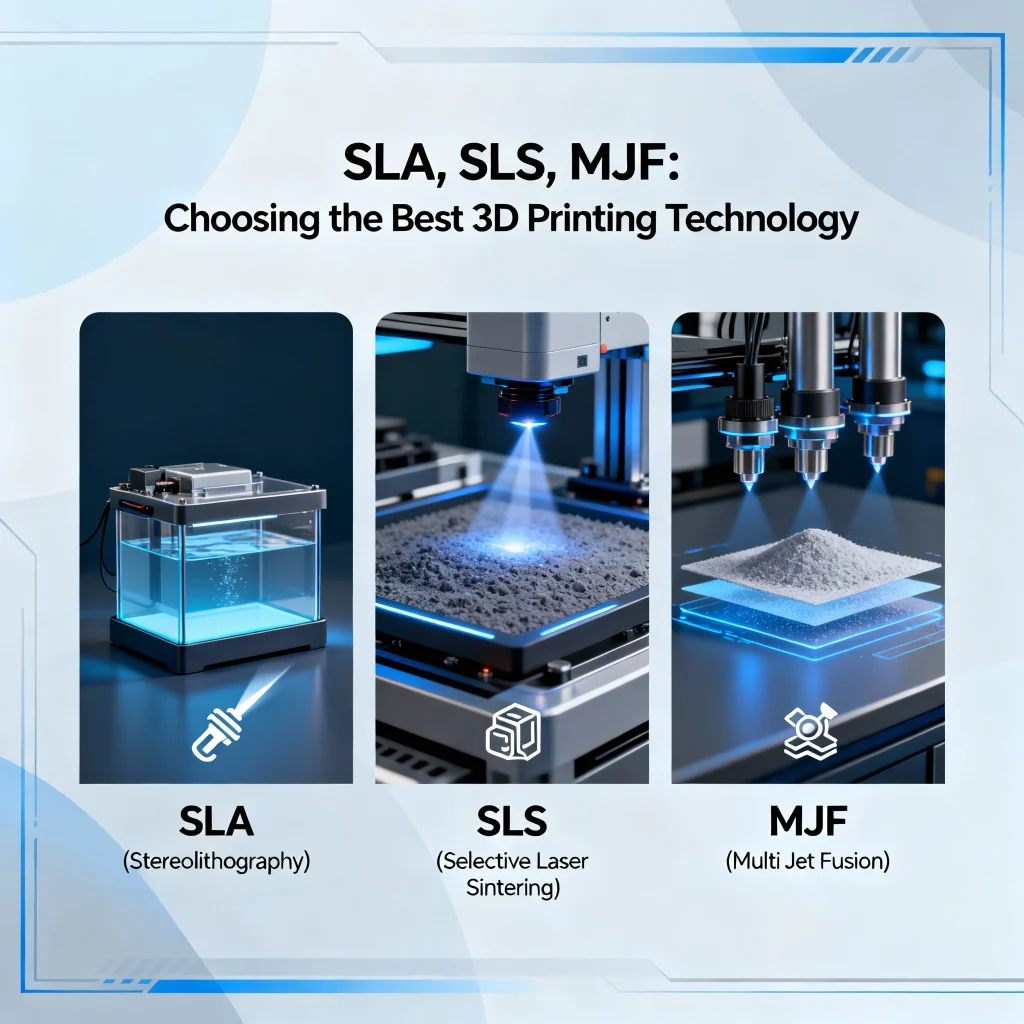
3D printing has revolutionized rapid prototyping and small-batch manufacturing. At Boona Prototypes, engineers and designers can access SLA, SLS, and MJF printing technologies to create parts that match their specific needs—whether for visual models, functional testing, or production-ready components.
I. Understanding the Technologies
| Technology | Full Name | Printing Method | Common Materials | Layer Thickness | Typical Tolerance |
|---|---|---|---|---|---|
| SLA | Stereolithography | UV laser cures liquid resin | Photopolymer resin | 0.05–0.15 mm | ±0.1 mm |
| SLS | Selective Laser Sintering | Laser sinters powdered nylon | PA12, PA11, GF Nylon | 0.1–0.2 mm | ±0.2 mm |
| MJF | Multi Jet Fusion | Fusing and detailing agents with infrared heat | PA12, PA11 | 0.08–0.12 mm | ±0.15 mm |
Learn more about Boona 3D Printing Services and how these technologies integrate with rapid prototyping and low-volume production.
II. SLA (Stereolithography) — Best for Visual Precision
SLA 3D printing uses a UV laser to solidify liquid resin, producing smooth, highly detailed parts.
Advantages:
-
Superior surface finish and accuracy
-
Ideal for transparent or detailed prototypes
-
Supports multiple resin types (rigid, flexible, clear)
Best Applications:
-
Concept models
-
Presentation prototypes
-
Mold masters
Example Parameters:
-
Build volume: 300 × 300 × 200 mm
-
Minimum wall thickness: 0.6 mm
-
Post-processing: washing, UV curing, polishing
III. SLS (Selective Laser Sintering) — Best for Functional Prototypes
SLS 3D printing fuses powdered nylon into solid parts using a laser beam. The unsintered powder acts as a natural support, enabling complex geometries.
Advantages:
-
Excellent mechanical strength
-
No support structures required
-
Resistant to wear and temperature
Best Applications:
-
Functional prototypes
-
Housings, brackets, hinges
-
Batch production
Example Parameters:
-
Build volume: 350 × 350 × 400 mm
-
Tensile strength: 48 MPa (PA12)
-
Elongation at break: 20%
-
Post-processing: sandblasting, dyeing, sealing
IV. MJF (Multi Jet Fusion) — Best for Production Efficiency
MJF 3D printing combines powder-bed fusion with detailing agents and infrared energy. It delivers faster builds and consistent mechanical properties across parts.
Advantages:
-
Uniform strength and accuracy
-
Faster batch production
-
Better surface finish than SLS
Best Applications:
-
Functional components
-
End-use parts
-
Medium-volume runs
Example Parameters:
-
Build volume: 380 × 284 × 380 mm
-
Tensile strength: 50 MPa
-
Elongation at break: 15%
-
Post-processing: smoothing, coloring, sealing
V. Comparison Table: SLA vs. SLS vs. MJF
| Criteria | SLA | SLS | MJF |
|---|---|---|---|
| Surface Finish | ★★★★★ | ★★★ | ★★★★ |
| Mechanical Strength | ★★ | ★★★★★ | ★★★★★ |
| Production Speed | ★★ | ★★★★ | ★★★★★ |
| Dimensional Accuracy | ★★★★★ | ★★★★ | ★★★★ |
| Material Variety | ★★★★★ | ★★★★ | ★★★ |
| Cost Efficiency | ★★ | ★★★★ | ★★★★★ |
| Post-Processing Need | High | Medium | Medium |
VI. Choosing the Right Technology
| Use Case | Recommended Method | Reason |
|---|---|---|
| Transparent or fine visual prototype | SLA | Superior clarity and precision |
| Functional prototype under load | SLS | Strong, durable nylon |
| Batch production of functional parts | MJF | Fast and uniform output |
| Complex internal structures | SLS / MJF | No supports needed |
| Low-cost visual models | SLA | Lower resin cost for small items |
VII. Integrating with BOONA Manufacturing Ecosystem
Beyond 3D printing, Boona offers integrated solutions for CNC Machining, Injection Molding, and Surface Finishing, enabling seamless transition from prototype to production.
Key Features from Boona Prototypes:
-
1-on-1 engineering support
-
Rapid turnaround (as fast as 3 days)
-
Tolerance up to ±0.01 mm
-
ISO 9001 quality management
-
Free manufacturability analysis
Visit Boona Rapid Prototyping Service to explore how you can accelerate your product development process.
VIII. Final Recommendations
| Priority | Best Technology | Why |
|---|---|---|
| Visual appeal and detail | SLA | Smooth finish, fine resolution |
| Durability and function | SLS | Robust nylon parts |
| Speed and scalability | MJF | Efficient batch production |
Selecting the right technology depends on your project goals, material requirements, and production volume. By partnering with Boona Prototypes, you gain access to expert engineers and advanced 3D printing capabilities—all under one roof.
FAQs
1. What is the difference between SLA, SLS, and MJF 3D printing?
SLA (Stereolithography) uses a UV laser to cure liquid resin for high-detail models.
SLS (Selective Laser Sintering) fuses nylon powder using a laser for strong, functional parts.
MJF (Multi Jet Fusion) uses a fusing agent and infrared energy to build parts faster with consistent strength.
Each technology suits different needs depending on detail, strength, and production volume.
2. Which 3D printing technology gives the best surface finish?
SLA printing provides the smoothest and most detailed surface finish, making it ideal for presentation models and prototypes requiring visual appeal.
For functional parts, MJF offers a smoother finish than SLS while maintaining mechanical strength.
3. Which method is best for functional or end-use parts?
Both SLS and MJF are great for functional parts.
-
SLS parts are durable and ideal for mechanical testing or small production runs.
-
MJF offers faster build speed, better uniformity, and is often preferred for batch production of end-use parts.
You can learn more at Boona MJF 3D printing service page.
4. How do I choose between SLA, SLS, and MJF for my project?
Choose based on your goals:
-
SLA → Best for aesthetics, fine details, and smooth surfaces.
-
SLS → Best for strength, complex geometries, and functional prototypes.
-
MJF → Best for scalable, cost-efficient production with consistent strength.
You can consult Boona Prototypes for expert recommendations tailored to your part’s function and materials.
5. What materials are used in SLA, SLS, and MJF printing?
-
SLA: Photopolymer resins (clear, rigid, flexible).
-
SLS: Nylon (PA12, PA11), glass-filled nylon, or TPU.
-
MJF: Nylon PA12 or PA11, often enhanced with color or chemical resistance.
For detailed material specs, visit Boona 3D printing materials page.
6. Which technology is most cost-effective for large batches?
MJF is typically the most cost-effective for medium to large batch runs.
Its ability to produce many parts simultaneously with minimal post-processing reduces overall cost per part.
SLS is also efficient for functional prototypes in smaller volumes.
7. Can SLA, SLS, and MJF parts be post-processed or painted?
Yes, all three can undergo post-processing for aesthetic or functional improvements.
Boona Prototypes offers surface finishing, painting, polishing, and dyeing for customized appearance and durability.
Check Boona surface finishing services for options.
8. What tolerances can I expect from these technologies?
| Technology | Typical Tolerance | Surface Finish Quality |
|---|---|---|
| SLA | ±0.1 mm | Excellent (smooth, high gloss) |
| SLS | ±0.2 mm | Good (slightly rough) |
| MJF | ±0.15 mm | Very good (matte and consistent) |
Actual tolerances depend on part geometry and post-processing.
9. Are SLA, SLS, and MJF prints durable enough for real-world use?
Yes.
-
SLA parts are best for visual validation or light-duty applications.
-
SLS and MJF parts are mechanically robust, suitable for industrial components, jigs, and fixtures.
Many manufacturers rely on these technologies for low-volume production.
10. How fast can Boona Prototypes deliver 3D printed parts?
With advanced in-house facilities, Boona Prototypes can deliver 3D printed parts within 3–5 days, depending on part complexity and finishing requirements.
You can request a free quote or upload your CAD file directly through Boona rapid prototyping page.



